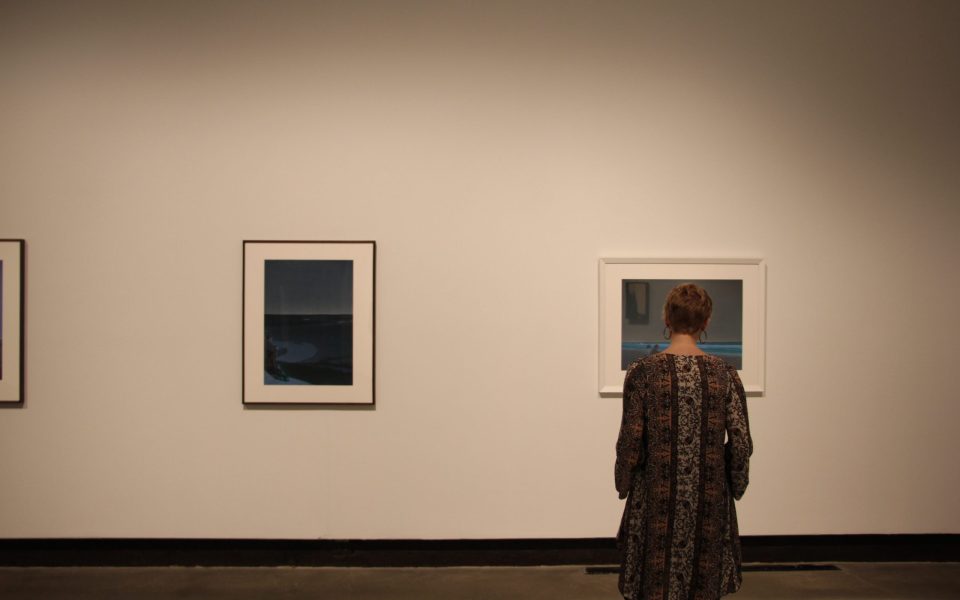by Daniel Wirtheim
When Southeastern Center for Contemporary Art exhibitions curator Cora Fisher began selecting pieces for a Devin Leonardi exhibit, she had no idea that she would be showing a retrospective. The collection, Figure at Dusk, opened at SECCA nearly a year after the artist’s suicide.
Themes of isolation and an afflicted American ethos are consistent throughout the artist’s short career. Leonardi paints from 19th Century and early 20th Century photographs. That is, he uses the photographs as source material to create new meaning from old visual narratives.
Leonardi’s early work, starting around 2006, is mostly black-and-white portraits of a racially divided America. There are no Confederate flags or slaves in Leonardi’s work. It’s not about exposing injustice as much as it providing a platform for talking about American identity through history.
In “Charleston,” three sullen black children hunker at the base of a column, surrounded by ruins of a once-great society, a foretelling narrative of Charleston’s recent racially fueled killings.
Another from his earlier period, “Mississippi Springs,” is more elegant and telling of Leonardi’s political playfulness. Along a river town, swans bathe under a “Saloon for white patrons.” Six figures, both white and black, stand along the riverbank. The moving figures are painted in blurs, much like a photograph of the time would pick up movement. There are no wires in the electrical lines, and what appears as inadequate painting plays into a larger narrative of American identity crises occurring during the Industrial Revolution. More often than not, that narrative is of isolation and disenchantment.
In the few instances where the narrative takes on a celebration-of-times-gone-by feel, the result is eerie — almost supernatural.
“Trappers on the Little Missouri” is a hipster’s paradise. Two men rowing a boat have stopped their movements to stare at the viewer with the still and earnest 19th Century portrait-photography look. One sports a long beard, and rifles lie in the boat. The canyon they row through could be on the surface of Mars. Stars illuminate the sky, giving the paintings a striking, mythological feel.
Leonardi’s mid-career paintings are marked by a 2010 move to Montana, where he took on visual narratives of Western expansion, often depicting his subjects as submissive to nature.
In “Will Avery,” a man in a white hat, presumably the hero, looks gravely towards the ground. He might be praying. He’s well dressed, too well dressed to be traversing the Western frontier. He holds the reins of a black horse with a rifle tucked in its saddle. The colors are muted, but expressive; a grayish-blue sky above a yellow-golden field. Leonardi’s landscapes engulf the subjects so as to leave the focus on the inevitable submission to nature.
“Two Friends Somewhere Along the Shore of Long Island” is the obvious hit. The shoreline weighs on the bottom third of the painting, allowing a star-studded sky to breathe in the larger upper portion. Below, a man and woman in 19th Century dress sit in the lower left corner, their bodies facing the ocean. Darkness surrounds them, and stars fluoresce the sky. It has all the elements of Devin Leonardi — the isolation, the longing for some transcendent feeling always beyond reach and an appreciation for the transience of American innovation.
In his last year of painting, Leonardi’s internal strife is more explicit. The artist’s suicide hangs over the exhibit like a dark cloud.
A dead, twisted branch is set before a night sky in “The Woods are Black, but the Sky is Still Blue,” a depressing piece of art that seems to hint at Leonardi’s tortured mind. In “Strains of Happiness,” cattle bones are piled high, making up the lower third of the painting that is otherwise a white, blank sky. The most telling of Leonardi’s lost hope is “A Spark of Decency.”
On the edge of a densely wooded forest, outlined by a serene and meandering river, a small light pokes through the branches. It’s a miserable scene, one final flicker of hope before everything goes dark.
Join the First Amendment Society, a membership that goes directly to funding TCB‘s newsroom.
We believe that reporting can save the world.
The TCB First Amendment Society recognizes the vital role of a free, unfettered press with a bundling of local experiences designed to build community, and unique engagements with our newsroom that will help you understand, and shape, local journalism’s critical role in uplifting the people in our cities.
All revenue goes directly into the newsroom as reporters’ salaries and freelance commissions.


Leave a Reply